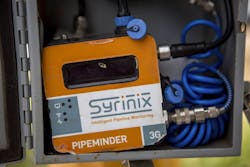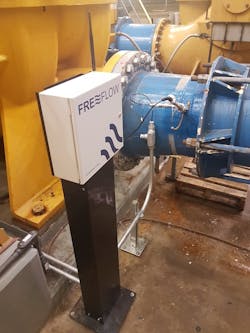Optimizing Operations to Improve Water Security
Rebecca Shanahan & Andrew Kingsford of WaterStart can be reached at [email protected] or 702.847.6630.
undefinedWe are living in an increasingly complex world, with significant challenges tied to climate change, population growth, industry and agricultural demand for water and our environment increasingly under threat from natural disasters, aging infrastructure and expanding cities and towns. There is no doubt that sound leadership in water management is critical for every community around the globe. Fortunately, many water managers partner with WaterStart as a global innovator that brings advancements in technology to enable water security and ensure it is delivered in the most sustainable and cost effective way.
At the center of the digital transformation, happening across WaterStart’s Members, is the Internet of Things (IoT). These smart devices take advantage of next generation telecommunications and transmit real time data, previously unobtainable by utilities, that now support a range of monitoring, analytical and predictive activities. Initially, utilities were looking to mitigate risk in their water and wastewater networks, but by utilizing IoT and smart water technologies, utilities are transforming their operations, enhancing their environmental credentials and in partnership with WaterStart, making more, safer, cheaper water. There are many examples of how this is quietly and effectively happening, and the following are just a few of the ways the water sector is benefiting from smart water technologies.
Xylem’s Water Network Optimization Solution
Xylem, a large water technology company, has developed a Water Network Optimization (WNO) solution, aimed to increase efficiencies and optimize operations. Through the development of a digital twin using existing hydraulic models and available SCADA data streams, one of WaterStart’s members responsible for operating a complex drinking water utility is evaluating the WNO solution to improve energy management strategies, enhance system performance and reduce operating and maintenance costs.
In addition to enhancing operations and identifying energy efficiencies, WNO can also assist utilities in water demand forecasting and perform real-time water quality optimizations. WNO is strategically designed to incorporate a utilities’ existing investments in IT, instrumentation, hydraulic models and other infrastructure or third-party integrations. The results are accurate estimates of current demands, pressures, flows, and tank levels throughout the service area that reflect past operational actions, and optimized guidance about future pumping and valving strategies that will improve water quality and delivery efficiency.
It was important to WaterStart’s member to have a “Glass Box” versus a “Black Box” design principle, thereby empowering operators to make long-term sustainable management decisions in real-time.
“If successful, this joint test project may help revolutionize how the water industry manages its operations,” said Nathan Allen, WaterStart managing director.
Syrinix PipeMinder-S
Syrinix monitors pipelines for pressure transients (changes in pressure) traveling through distribution networks and is positioned to monitor for pressure transients in transmission lines. These pressure transients are a primary cause of leaks and other damage to infrastructure. PipeMinder-S technology can identify the cause of transients and eliminate them, thereby reducing leakage, pipe breakage and potentially reduce negative transient related water quality impacts.
The device connects to hydrants or other valve connections, from which it sends data to an online portal. During testing and demonstration by one of WaterStart member utilities, Pipeminder-S detected when certain pipelines were experiencing pressure peaks that other monitoring devices would have not picked up, and as such, the utility was able to take action in solving this issue, and prolong the lifespan of their pipelines. The cost of one saved pipe burst equated to the cost of the installation and the hardware purchased.
Riventa Freeflow Thermodynamic Pump Monitor
Riventa installed its thermodynamic pump monitoring technology that provides hydraulic, electrical power and motor efficiency measurement, as well as asset performance information with a WaterStart member who had difficulty understanding the efficiency of various pumps, how to identify opportunities for cost savings, and when to upgrade pumps and electrical components. By installing Riventa Freeflow technology, this member improved pump scheduling based on demand, which increased the pump lifespan, saved electricity costs and improved overall pump efficiency.
Samotics SAM4 Motor Condition Monitoring
Other utilities are utilizing IoT sensors to create smart predictive maintenance solutions for remote assets. SAM4 is a plug-and-play condition monitoring solution for critical AC motors and rotating equipment.
Developed by Samotics, the IoT sensors can be installed directly into the control cabinets versus the asset itself and are capable of monitoring assets for both mechanical and electrical failures around the clock while also generating high-frequency data for automated analysis. A notification can be sent directly to the user detailing the presence of a fault, the type of fault, and recommended actions.
SAM4 also monitors energy usage and proposes interventions to optimize pumping efficiencies. A WaterStart member was interested in testing sensor monitoring systems that utilizes motor current signatures, rather than vibrations on various asset types, and installed SAM4 across a suite of assets in water and water recycling applications, including submersible network pumps, abstraction pumps, screws and centrifuges. Establishing a baseline for asset condition and performance using real-time data will assist in avoiding catastrophic failures of critical assets and reduce unplanned down-time and energy waste.
Pipe Insight iTracker
Many of our members face challenges of managing the delivery of safe and reliable drinking water under extreme drought while others are seeking solutions to manage consequences of significant rain events. Many utilities are searching for cost efficient technologies to pinpoint locations of storm water inflow and infiltration down to manholes in their sewer systems after rain events. Why does infiltration of storm water matter for wastewater managers? It matters because it reduces the capacity of the sewer system which can lead to increased flooding, reduced water quality, and pollution. Operating costs are increased and performance is reduced when sewer systems encounter increased, and unexpected, flows.
Pipe Insight has developed iTracker, a suite of low-cost sensors with wireless connectivity and high-powered analytical software capable of locating and measuring inflow and infiltration after just a single rain event. With it, there is no need to accept the additional costs and risks of on-site data retrieval and confined space entry, enabling timely and cost-effective mitigation measures.
WINT & Apana Data & Monitoring Tools
IoT and Smart Water technologies have applications in large hotels, casinos and complex facilities that require water for many functions, such as irrigation, cooling and plumbing to restaurants, spas and pools. These facilities are looking to increase water efficiency, reduce water waste, and prevent water leaks As such, the need to monitor and analyze data in real-time can help them get control of their water usage. Two technologies, WINT Water Intelligence (WINT) and Apana, have been tested and fully integrated in the operations of hotels in northern and southern Nevada. As a smart system that uses data analytics, WINT can create detailed profiles of water usage and provide close to zero false positive alerts when detecting water waste events.
Apana can monitor and partition water uses at facilities and conduct high-resolution troubleshooting to identify water conservation opportunities. These smart water solutions have identified savings in water and energy and will continue to play a critical role in conservation efforts.
Conclusion
Modern utilities and other large consumers of water are paving the way for smart technology adoption and in doing so, are ensuring that all of us have access to clean drinking water and advanced wastewater services. The examples demonstrated have reduced utilities’ carbon footprint, minimized risk of supply and created greater economic development for the communities and technology organizations involved in transforming water utilities in the 21st century.

